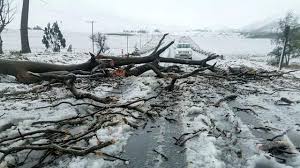
South Africa Floods Kill at Least 49, Students Swept Away in Bus Tragedy

 :
| Updated On: 12-Jun-2025 @ 12:02 pm
:
| Updated On: 12-Jun-2025 @ 12:02 pmSHARE
At least 49 people have died due to severe flooding in South Africa’s Eastern Cape province, following an intense cold front that brought torrential rain and widespread snowfall to various parts of the country. The weather conditions, described as extreme, resulted in large-scale destruction and displacement, especially in the southern and eastern regions.
Eastern Cape Premier Oscar Mabuyane, speaking at a press briefing on Wednesday, stated that the official death toll, confirmed by police, is expected to rise as rescue and recovery operations continue. He noted that additional bodies were being found even as he spoke. The catastrophic weather event led to numerous tragedies, including one particularly heartbreaking incident involving school children.
According to authorities, six high school students lost their lives on Tuesday when their school bus was swept away by rising floodwaters near a river. Four other students remain missing, and the search for them is ongoing. The bus was recovered the following morning, but it was empty. In a small sign of hope, three students were rescued on Tuesday after being found clinging to trees by rescue teams.
Disaster response units have been mobilized in both the Eastern Cape and the neighboring KwaZulu-Natal province in response to the flooding. The torrential rains over the weekend severely affected these areas, damaging infrastructure, cutting power supplies, and rendering many roads impassable. Officials reported that hundreds of thousands of homes experienced power outages, worsening the crisis for those already dealing with flood damage.
In addition to residential damage, key public infrastructure was also hit hard. Eastern Cape officials reported that at least 58 schools and 20 hospitals suffered flood-related damages, impacting essential services like education and healthcare. As a result of homes being washed away or rendered uninhabitable, around 500 people have been relocated to temporary shelters established by local authorities and disaster relief agencies.
Premier Mabuyane described the situation as unprecedented in his experience, highlighting the scale and severity of the destruction. “I have never seen something like this,” he said, underlining the gravity of the disaster.
South African President Cyril Ramaphosa has expressed his condolences to the families affected by the tragedy. In a public statement, he emphasized that the national government, through the National Disaster Management Centre, is actively collaborating with provincial and local authorities to coordinate emergency response and recovery efforts. Relief operations are being intensified to provide immediate support, restore services, and search for the missing.
Weather experts had issued prior warnings about the arrival of a powerful cold front, predicting damaging rains and snowfall in the eastern and southern parts of South Africa. Despite these forecasts, the full extent of the devastation appears to have exceeded expectations, prompting calls for better preparedness and infrastructure resilience against climate-driven weather extremes.
As search and rescue operations continue, the focus remains on finding the missing, providing aid to displaced residents, and assessing the long-term impact of the floods on affected communities. The tragedy has underscored the vulnerability of many South African regions to extreme weather events and the urgent need for climate adaptation strategies.
Contact Us
House. No. : 163, Second Floor Haridev Rd, near Puberun Path, Hatigaon,Guwahati, Assam 781038.
E-mail : assaminkcontact@gmail.com
Contact : +91 8811887662
Enquiry
×
Reporter Login
×